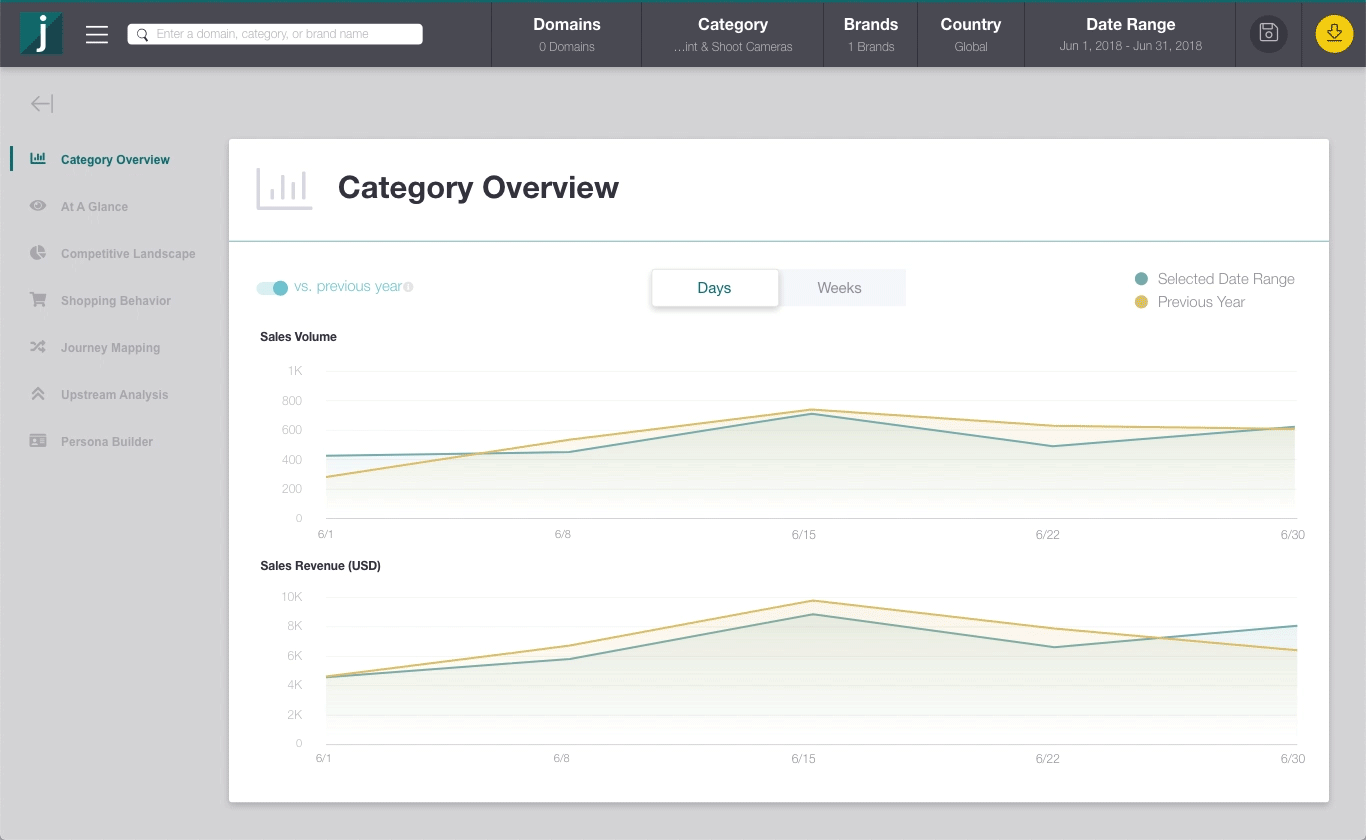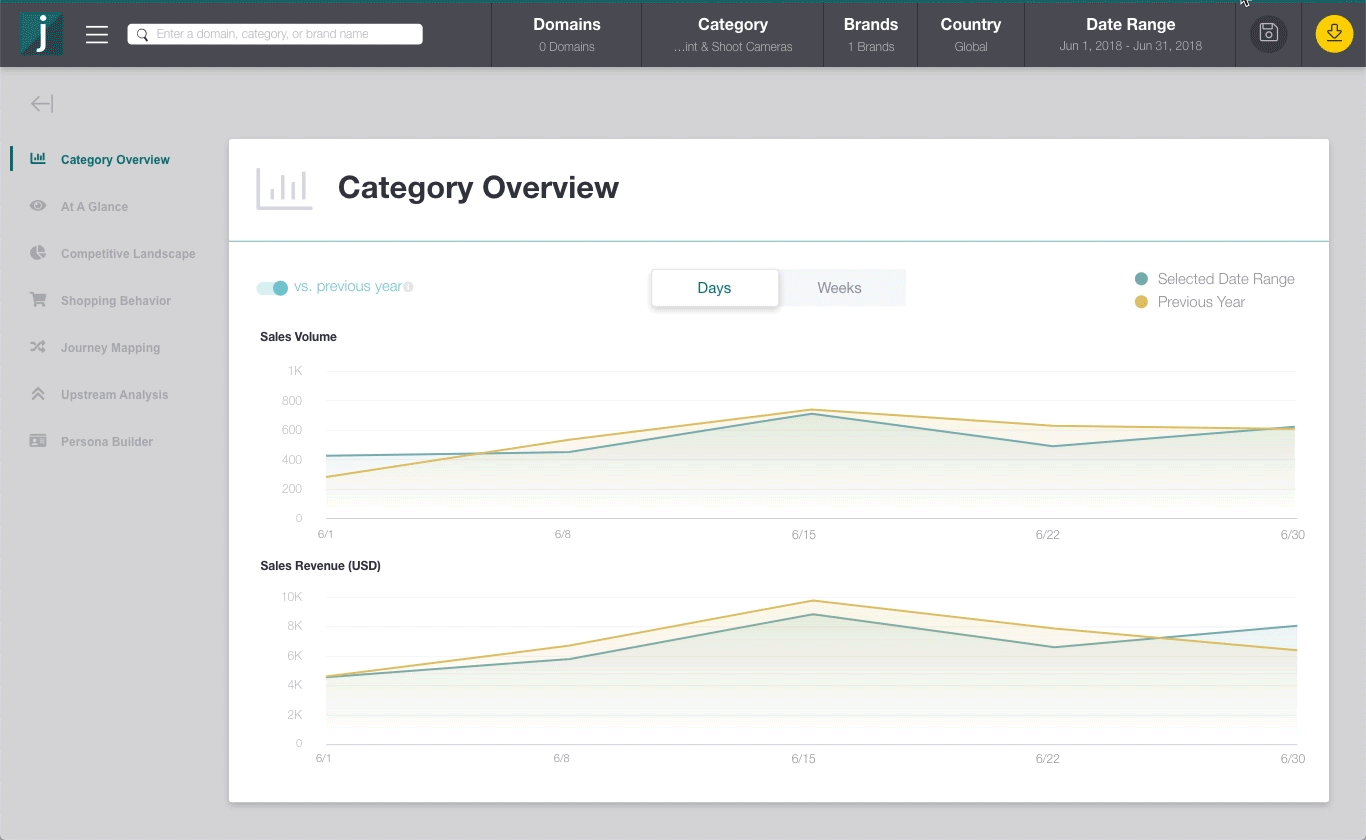
Jumpshot - Data Insights Platform
Jumpshot was a rapidly growing startup that provides eCommerce data and competitive analytics down to the domain, brand, and category level for consumer behavior online. At the time of this project there was 170+ employees - with five members on the product team and 80+ engineers based out of our main offices in San Francisco, New York, and Prague.
About the Project
Stakeholders
Customer Success
Product
Marketing
Engineering
Sales
20+ member team
1 Product Manager
1 Designer (me)
Engineering (Front-End & Full Stack)
Target users
eCommerce Brand Managers & Directors
Timeline
6 months
My role
For this project I was the sole Designer and I was responsible for providing the expertise on user insights and conducting research, rapid iteration of wireframes/prototypes, and final design specification.
Defining the Problem
Summary
Jumpshot was having success with recurring data reports and custom requests, but the data insights team was overloaded and this was not a scalable business model and the product team began working on an insights tool that could deliver live data to our customers. However, there was little-to-no success selling this product as it presented and offered to customers.
“Okay I see the data…
Now what do I do with it?”
So why was this happening? Why weren’t our existing customers interested in the live data even though they were already paying for our data reports? Jumpshot found itself in a tough position and allowed me to be the sole UI/UX designer to work with the product manager and engineering team to develop a valuable product that new and existing customers want.
My perspective
The first pattern I noticed was that the user’s perspective wasn’t being included in development process. In addition, the majority of the stakeholders weren’t aware of the benefits of adopting a user-first mindset and that would be the first challenge as the sole UI/UX Designer on the project. The methods I use to address this will be covered later!
Conducting User Research
Introducing user research into the discussion and getting stakeholders on board
I met with the CTO, product manager, various stakeholders to discuss user research. During those discussions we agreed that we would initiate a strong effort to fill the knowledge gaps for the problem/solution fit for our customers. The product manager and I carried the momentum of this successful discussion and pursued our most obvious lead: our small but very valuable customer panel that was in touch with our Customer Success team.
We reached a point where we felt more confidence that our target persona is correct and that we provide the appropriate data sets for them to use in our platform, but also identified some concerns that needed to be addressed as we moved forward:
We struggled to get in contact with our customers
Little emphasis on industry discovery and research on individuals who work in similar positions outside our target personas
The current amount of data was too narrow to be a proper representation of our entire potential market
Making adjustments to optimize our research efforts
We quickly realized that we needed to expand the number of users to develop a proper perspective for our users and their needs. So the product manager and I researched ways we could extend our outreach for possible interviewees and discovered userinterviews.com to recruit participants that we wouldn’t interact with if we continued to rely on our internal network.
Below are some direct quotes that represented the common themes and responses we received that helped us understand their point of view:
The sessions were facilitated by the Product Manager and I - with one person speaking/directing the conversation while the other took notes. We were able to create persona profiles to represent a snapshot of our target customers with their corresponding role and goals. Sara from Popsockets was one of our examples:
Name and imagery changed for privacy
Gathering the requirements
The impact of the sales model on the userflow
We also had to be mindful of the sales model as concurrent conversations were happening in other areas of the business. This diagram below represents the different types of permissions the user may have access to, adding a layer of complexity that also had to be properly addressed in the solutions our team was working on.
Varying levels of permissions that affect what the user sees and can interact with
Brainstorming with Product Managers & Engineers
Lots of whiteboarding sessions and lots of ugly, yet invaluable sketches
The product managers and I worked very closely over bi-weekly sessions to discuss and sketch ideas inspired by our research. With the engineering team in Prague, it was crucial for us to operate at a rapid pace so that we could share our progress with them during our product/engineering weekly syncs.
This was the phase we used to analyze the details of our proposed solutions and see if they are actually viable before we begin building, and it helped us develop numerous hypotheses that we wanted to continue investigating with our low-fidelity prototypes that we would soon create.
They grudgingly gave their consent to be included in these photos
Now the independent design work begins
Ideating the userflow
In this diagram I’m trying to sympathize with what the user may be thinking while navigating through our app to allow us to explore when our data cards will be useful to them.
How does a user get started?
A user can begin by searching for the first domain, brand, or category that comes to mind. But more importantly, they should also be able to browse the lists we have available in case they are unsure of what they want to search for.
Sketching out data visualization
The possibilities with data are endless, so we had dozens of design cards iterations exploring possible ways to display the data in a way that the users found valuable. In the end we narrowed it down to nine cards that will be shown for the user’s search query, and referring back to the flow diagram above, was seven variations.
With the different types of data and varying permissions,
I explored over 100 card iterations!!!
We determined the best way to display these data visualizations and allow the user to interact with them was to utilize a type of card design
Establishing Design Specifications
Inspiration from our corporate brand
Adjusting them for product use
These colors were too heavy and saturated for all the bar charts, lines and pies that were going to be displayed. So I adjusted them to a lighter palette for our user interface. I also needed to provide ten since there would be that many unique elements that needed to be identified in the data.
Crafting additional elements and components
I created a component library to begin crafting the product with more efficiency, as well as provide all the resources needed for the development team so they can push it into production.
Bringing it all together
Providing detailed design specifications for the engineering team
After performing my due diligence with designing and providing specifications for every element necessary for our tool to be usable, I began working on the large components that were essential to the product and collaborated with the engineering team to make it a reality.
Once the card design reached a point we were happy with, I provided compositions that had detailed information accompanying it so that the engineering team could replicate it as a live, functioning tool. Here is one example of some of the content given to the engineering team:
The Final Designs
The culmination of all our hard efforts

A snapshot of the most relevant data for a user’s saved brand, category, or domain.
Demographic data and their affinity index towards sites and genres
Sources of incoming traffic such as channel, search engine, domain, and keywords.
Interest and competitive data within a shopping category.
Results
Going back to some of the tools we used the very beginning (specifically Pendo and other internal tracking metrics) We were able to keep track of the change in numbers over the course of the project. Some of the significant outcomes are:
24 Customers
204 Users
20 Daily active users, 87 Monthly active users, DAU/MAU = 37% Stickiness (Industry average 13)
1.5x increase in visitors YoY
54x Increase in user interactions YoY
20% average monthly user growth (industry average 3%)
Great customer relationships - users are willing to advise and be patient for future features.
Conclusion
A new process has been established
All of our work on this project became concrete evidence that adopting a user-centric mindset is very beneficial to all the stakeholders involved. And as a result, continuous research among our customers had now become a recognized step incorporated in our development process and our design proposals were backed by direct input from our users.
Outside of the product team, Customer Success even began offering newly acquired customers an opportunity to participate in our user research and provide their thoughts on new features.
A win for all
Overall, we started operating with less ambiguity now that we had an established way of resolving open questions and validating assumptions. There is still the challenge of synthesizing the data since user feedback isn’t always clear, but Jumpshot came a long way in terms of product design.
Takeaways
It takes time to become an expert for a complex product, but the payoff is worth it
At times I felt as if I was unable to contribute in the beginning because was still in the process of learning some of the complexities of the product. But over time it started coming naturally to me and I able to make a connection between the product’s capabilities and the needs of the user.
Collaboration is key
I realized very quickly that many members of the company can be allies outside of the two teams I interact with most (product and engineering). Maintaining a positive relationship and communicating with the Customer Success was crucial when it came to establishing a reliable connection with customers for feedback on our product.
It’s possible to overcome ambiguity and establish a user-centric approach for the company
Over the course of this project I was able to discover many tools and methods to establish a new process for user research despite being shorthanded on resources. And through proper communication and presentation, stakeholders are more than willing to support external user research however they can once they see the value.
Fin.
I have other work to share if you’re interested














































